Somewhere between John Singer Sargent and Jan van Eyck
By Al R. Young
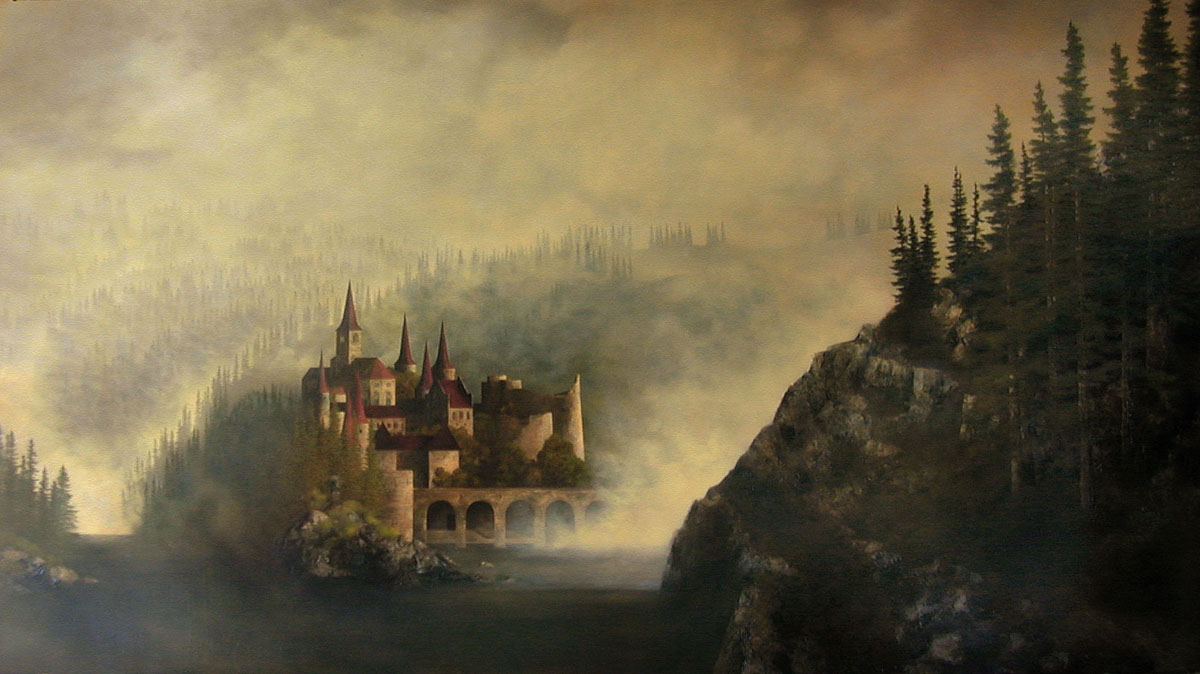 |
| The Grey Havens by Al R. Young |
dimensions (unframed width x height)
84 in. x 48 in.
support
Panel
milestones
Commission received and work begins — 2000
Painting completed — 2004 June
equipment created or modified for this project
Clamp-on glass-palette holder
costumes, miniatures, and props created for this project
None.
methodology
This section presents only one or two items that may be of interest to professional artists, amateurs, and others interested in the work of the Studios.
Every artwork lives on in the artist's memory, in the artist's compositions, in approaches to subjects, in skills and techniques, in stamina, and in the artist's thinking and feelings. In these and countless other ways the thing created, or acted upon, by the artist becomes a thing that acts not only upon the rest of the world, but the artist. Even failures have their place.
It is now eighteen years since I embarked upon The Grey Havens, and fourteen years since I finished it. While I cannot comprehend all the ways in which this project and its results live on in my life and work, I can say that one of the things that comes to mind whenever I think about it, is the memory of all those trees and the fact that I painted every one of them—all of the small ones that is—with a small sable. I seem to see 000 as the size printed on the shaft of the brush I used, which—though it is still a long way from a size like 20/0—is pin-headed compared to the 4,032 square inches of the panel's surface. And whenever I think of the trees, I hear the words of a very successful, professional-artist friend of mine: Always paint with the largest brush you can find.
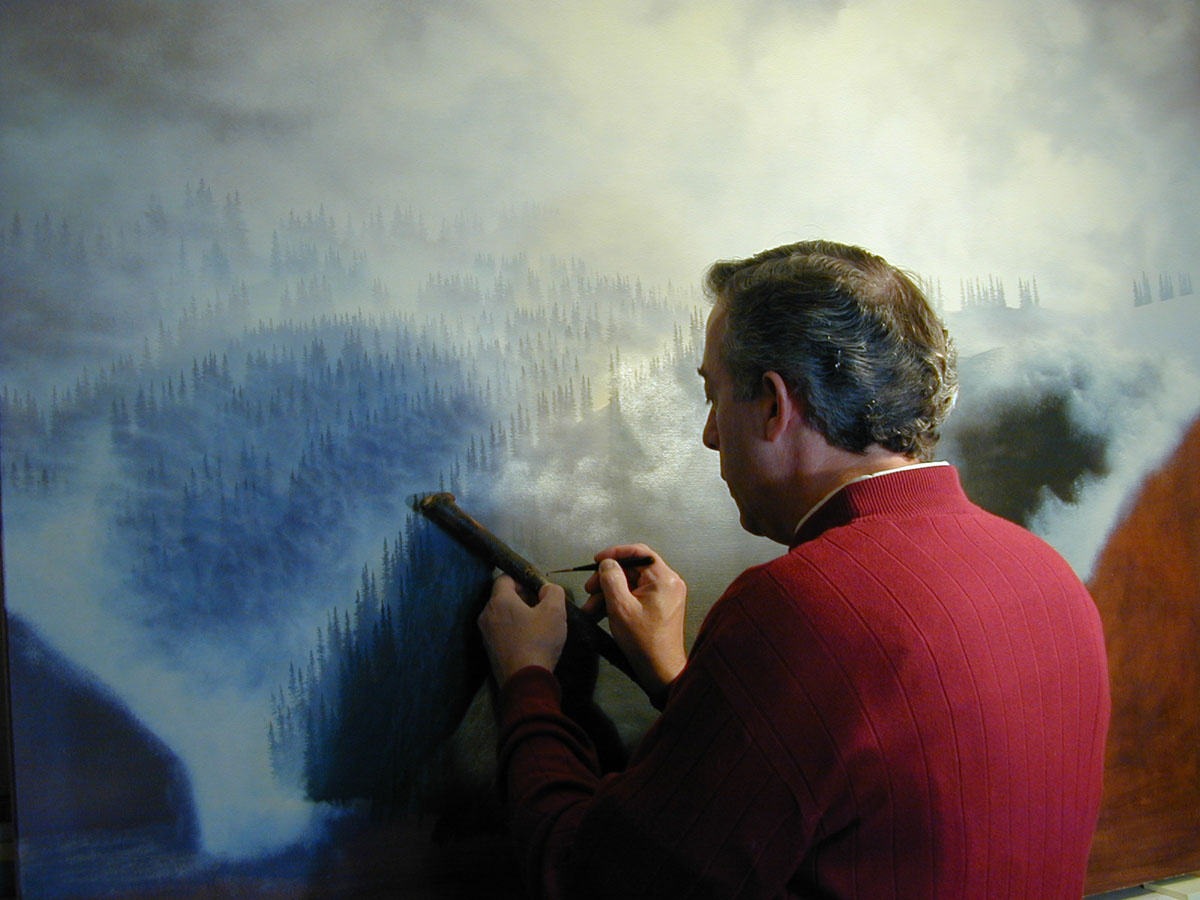 |
| Al painting the trees, even a few subsequently obscured by mid-ground and foreground elements. |
I don't know whether my friend would have given the same advice to everyone or whether he said what he did simply because he was familiar with my pencil drawings—in which I often used a No. 9 lead sharpened to a needle-point in order to render a cloudless sky (with the point, not the side of the lead). I am inclined to think there was a connection between what he observed in my drawings and what he said about painting, perhaps in the hope of helping me be as prolific a painter as possible—particularly in view of my desire to paint full-time for a living.
Since then, I have painted a great many pine trees. I don't always use the smallest sable I can find, but, as a general rule, I use a larger brush only when painting larger trees. And I still use essentially the techniques I used on The Gray Havens. By now, my decisions in these matters have been made and then galvanized in the furnace of everything that depends upon livelihood. From time to time, I think every artist looks at what he or she paints, how he or she paints it, how fast or slowly the painting progresses, how large or small the paintings usually are—the list is a long one—and marvels at what works and what doesn't, what sells and what doesn't. Sometimes there is an attempt to correct the situation or to accept it and make the best of it, at least to make peace with it. It's all part of the journey.
For me, deciding what to do in regard to this particular aspect of rendering seems to involve decisions about:
Amount of detail versus summary
Medium, tools, and techniques
Size of painting and quantity of compositional elements
Focal point and eye movement
How the painting will (or should) be viewed
I do not have a formula for bringing these factors together; or, perhaps more precisely, I cannot articulate such a formula. I can only identify some of the considerations of which I'm aware, and comment on them. At the very least, perhaps it will be reassuring to know that the life and work of a studio artist is filled with unknowns, questions, and decisions. And if that is what you're experiencing, you are probably right on course.
detail versus summary
In the first place, all rendering, or representation, is summary by definition. The question for me is therefore how much detail to include in the representation of any element in a composition. And one of the primary considerations in making that decision is how much I want my mark making to reveal or to hide my hand, in the finished artifact.
And in regard to this, I am seldom if ever constant in my desires: Sometimes I want to render so that almost no footprints (as it were) of the artist are present in the finished artifact, and sometimes I want to represent something merely by what appears to have been one swipe of bristles that fell upon the ground, leaving its budget of paint protruding from a sea of glazes like the snowy summit of a mountain peaking above the surface of an ocean of clouds. The decision falls somewhere between John Singer Sargent and Jan van Eyck.
It should also be remarked that if Sargent and van Eyck are the two extremes of my continuum of possibilities, my decisions—or anyone else's— would produce different results were the distance between my extremes greater or less, or somewhere else altogether along the continuum of absolute choices, whatever that may be. And in this observation, one bumps up against one of the really disturbing realities of painting or any other artistic expression, particularly for anyone who wants to know how to do this or that; namely, that if there are bounds and formulae governing these things (absolutely), only the angels know and use them.
medium, tools, and techniques
Of the many things that could be said about this infinity of options and interrelationship among them, I will only observe that sharpness of edges, depending, of course, upon the compositional element in question, and how that edge is executed relative to the mark-making involved in creating the work, is an important consideration. My mark-making is sometimes almost edgeless and at other times as crisp as a knife stroke. For stone, for example, I much prefer, as a general rule, crisp definition, which means my use of brushes, in painting stone, is largely confined to glazing. Knifed or wedged under-painting and over-painting lead out in defining contours.
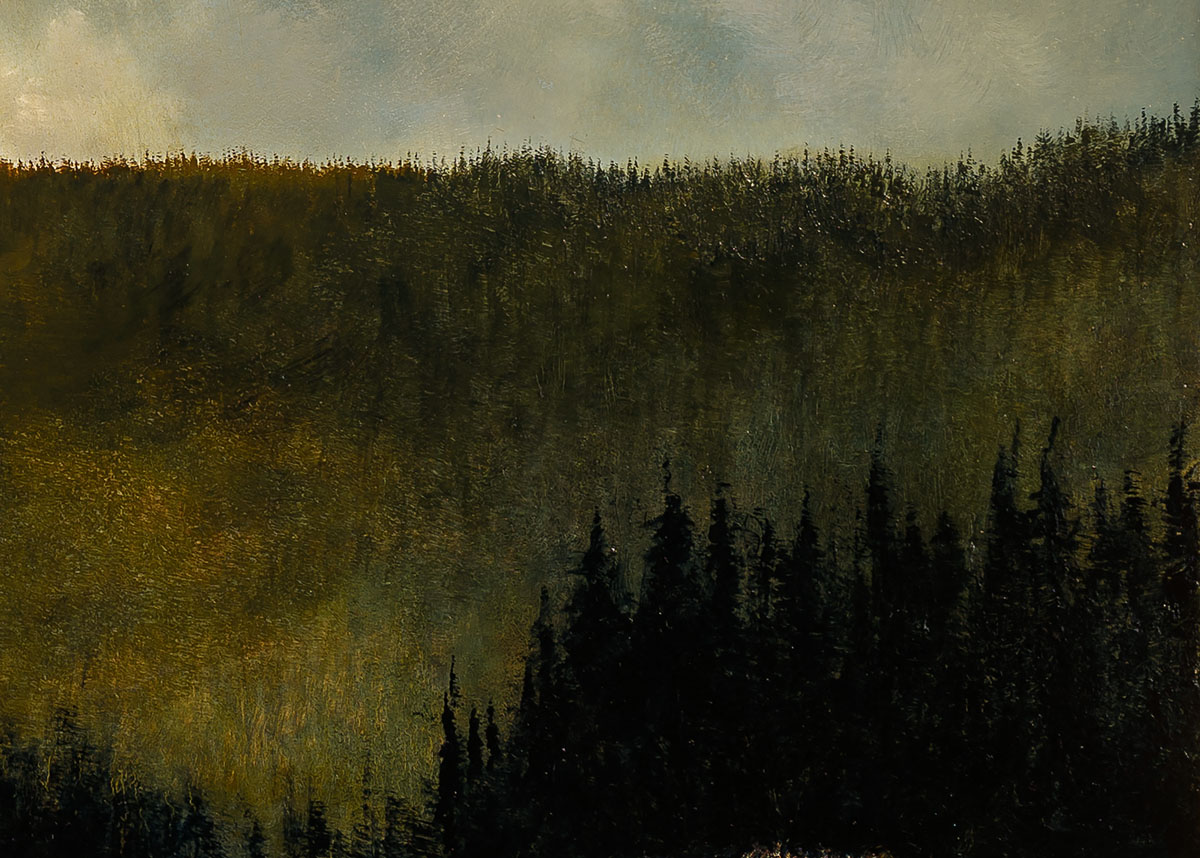 |
| Detail from Under the Northern Mountains by Al R. Young |
In the case of The Grey Havens, I could have used a much, much larger brush for the distant trees, but I didn't want to because I wanted to articulate the trees for the benefit of people with their nose against the painting as well as people either standing at a distance or viewing a small reproduction. In painting Under the Northern Mountains, every tree in the painting was executed with the loaded side of a bright, while most of the trees in Legend(see detail at the bottom of this page) were executed in much the same way as The Grey Havens
size of painting and density of compositional elements
It takes some time—not necessarily a long time, but enough for trial and error—to discover one's optimum scale, for even size, proportion, and orientation, like almost everything else about painting, are at least somewhat unique to the individual. As a general rule, I wind up painting relatively large pieces, even if I start out thinking I'm going to paint small. Nor do I altogether know why. I just know that I need a certain amount of what I can only describe as elbow room in order to feel comfortable.
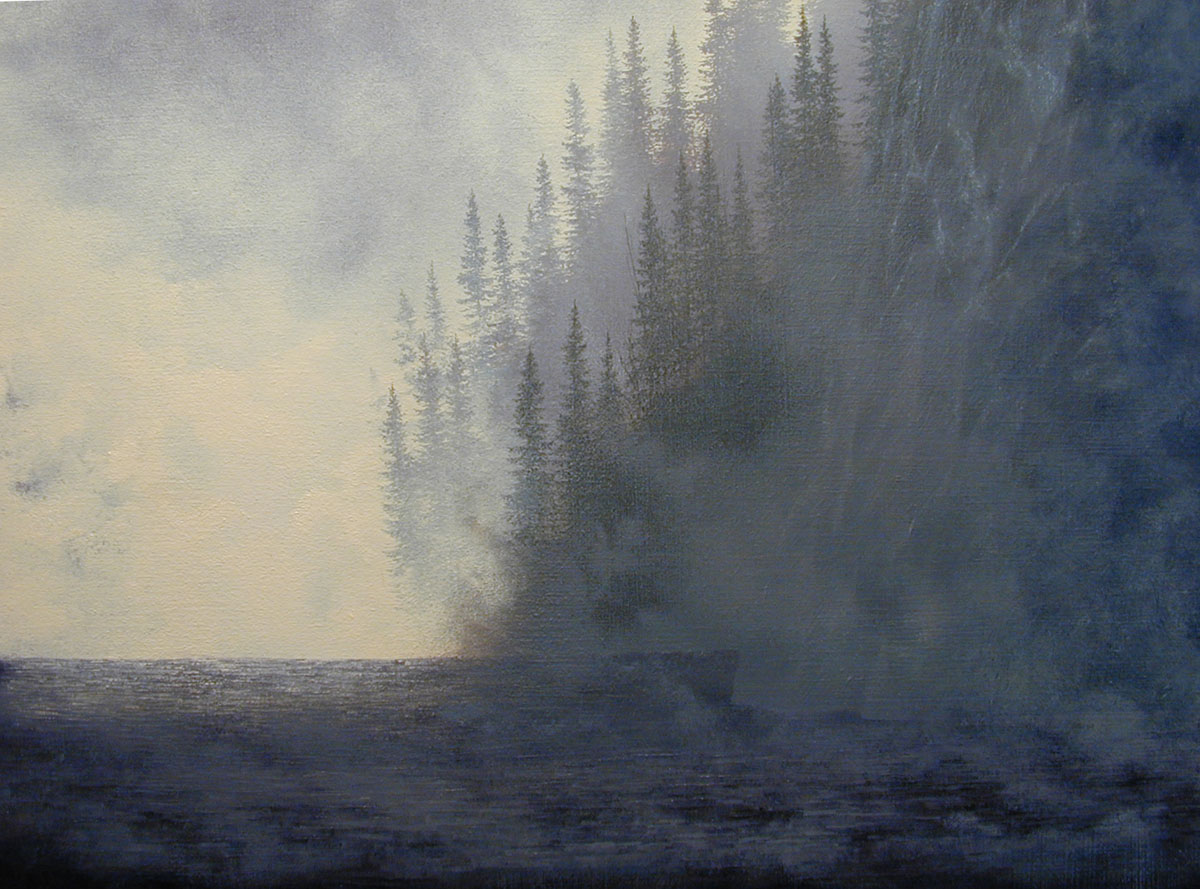 |
| Detail from the in-process photographs of The Grey Havens by Al R. Young |
focal point and eye movement
One of the traditional rules of perspective rendering is that objects in the distance are smaller and less detailed than objects in the foreground. However, there are also theories and rules about sight and rendering such that focus, or clarity in the rendering, need be governed by the focal point, with suggestion, or summary, radiating from that point. I typically follow some adaptation of both of these tenets, but not always. For example, my works often include objects in the distance that, for their size, are rendered with as much detail, proportionally, as objects in the foreground or the focal point, or perhaps what might be called the point of interest to which I would direct the viewer. And one of the reasons for this is that, particularly in terms of landscapes, I'm almost always interested in horizons. That's where I look most often. It's where I think. It's where my interests lie. Finally, the principles of perspective and interpretation must, I think, defer to considerations of eye movement in the configuration and execution of a composition.
how the painting will (or should) be viewed
Once upon a time, I was intrigued to discover that N. C. Wyeth created large paintings because, when reduced in size to serve as illustrations, the images looked like he wanted them to appear in the books for which so many were destined. In his case, working large also meant working faster, which, given deadlines and considerations of livelihood, were of great moment. I don't claim those reasons for what I do; I simply found the information interesting in much the same way that, at an early period, I was introduced not only to Carl Larsson's work as a muralist, but to his working environment, and I found myself entirely captivated by it, simply because it felt like native air to me. Sometimes we may guess or even know why we do what we do, but for me, creating artwork is very much a spiritual thing, and I often discover the why later, sometimes much later. And because the personal personal journey of an artist is inherently creative, it leads to the frontier.
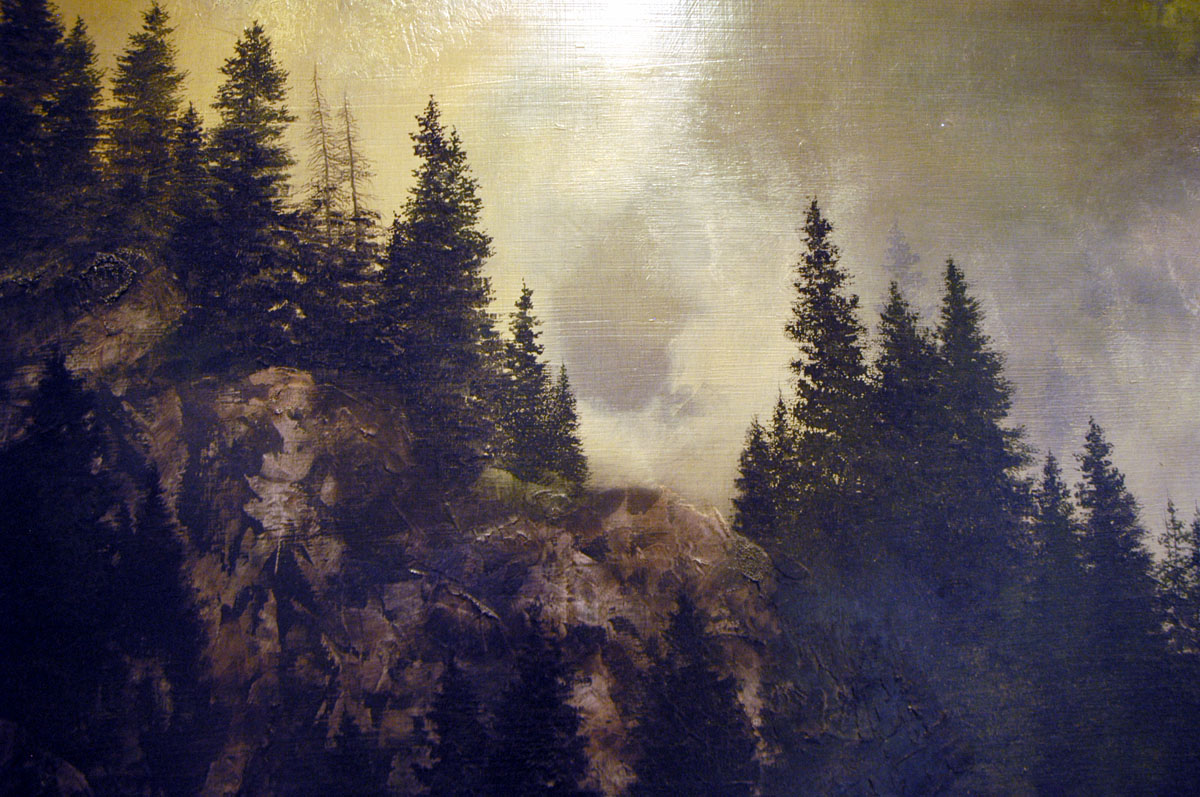 |
| Detail from Legend by Al R. Young |
This brief section presents examples of building up color and textures by means of thin, translucent glazes.
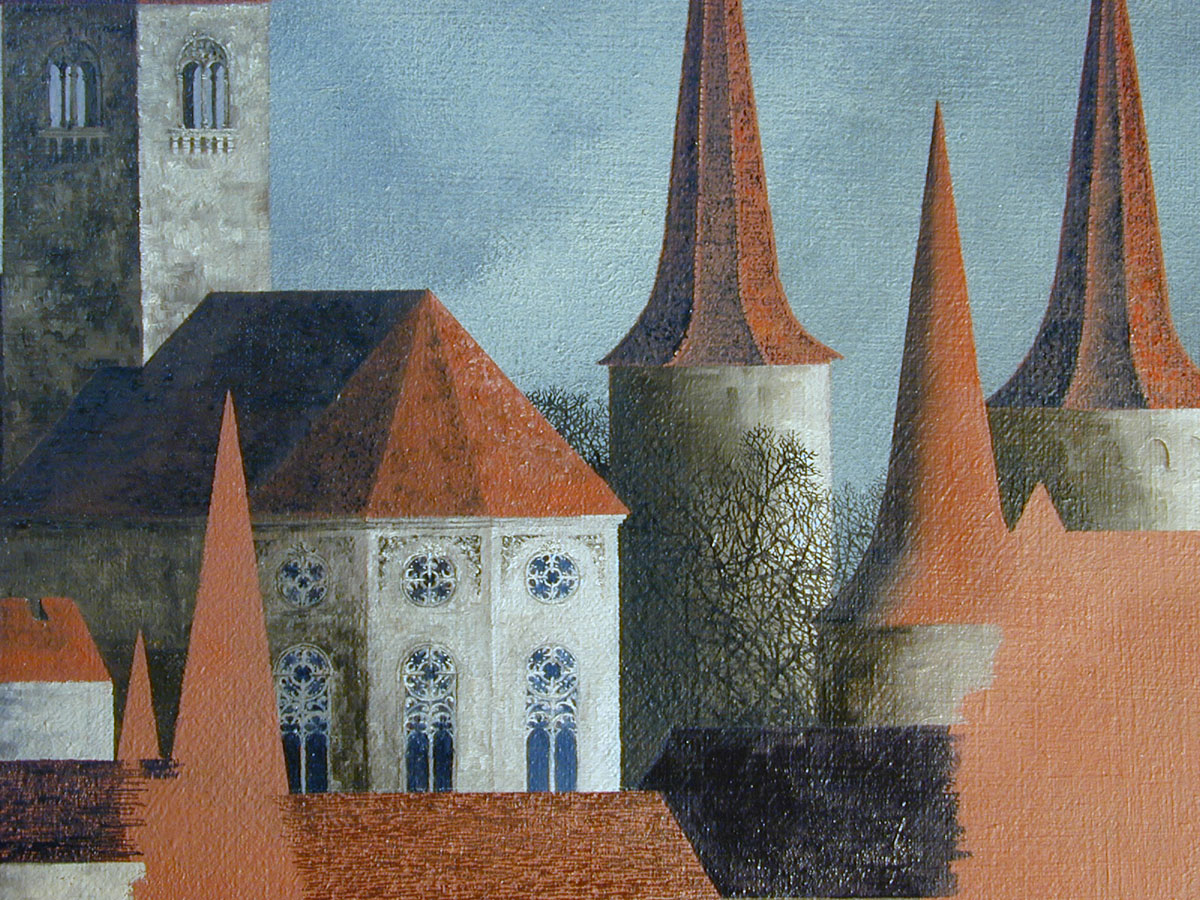 |
| This early under-painting focuses primarily on the structure and detailed articulation of elements, establishing contours and suggesting regions in which shadows will be draped, over the contours of the objects, to help provide the illusion of volume. |
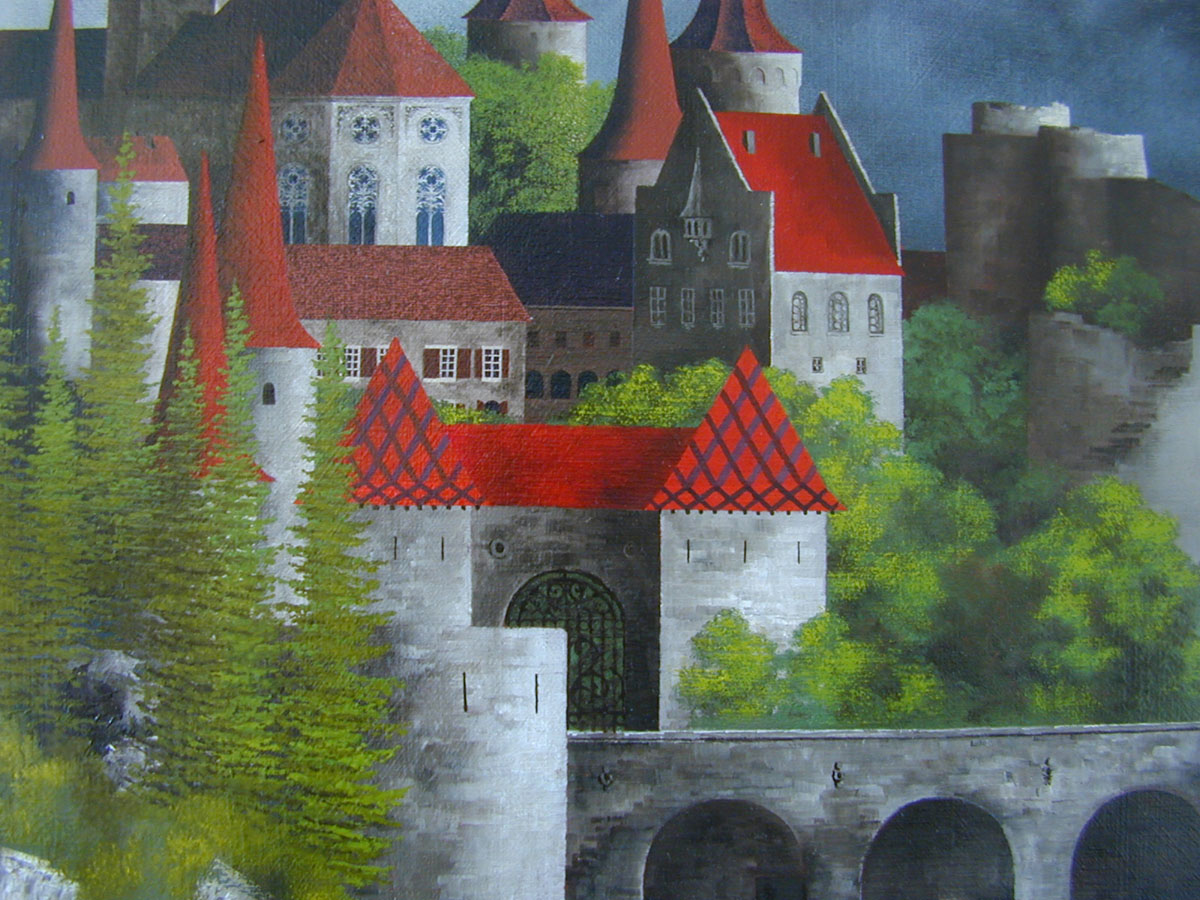 |
| As colors are added, initially, hues tend to be far more strident in their saturation, so that as subsequent glazes deepen shadows, while also narrowing the color-gaps between the hues, the visual elements settle into the mood or tonal relationships desired (i.e., the color reality posited by the painting). |
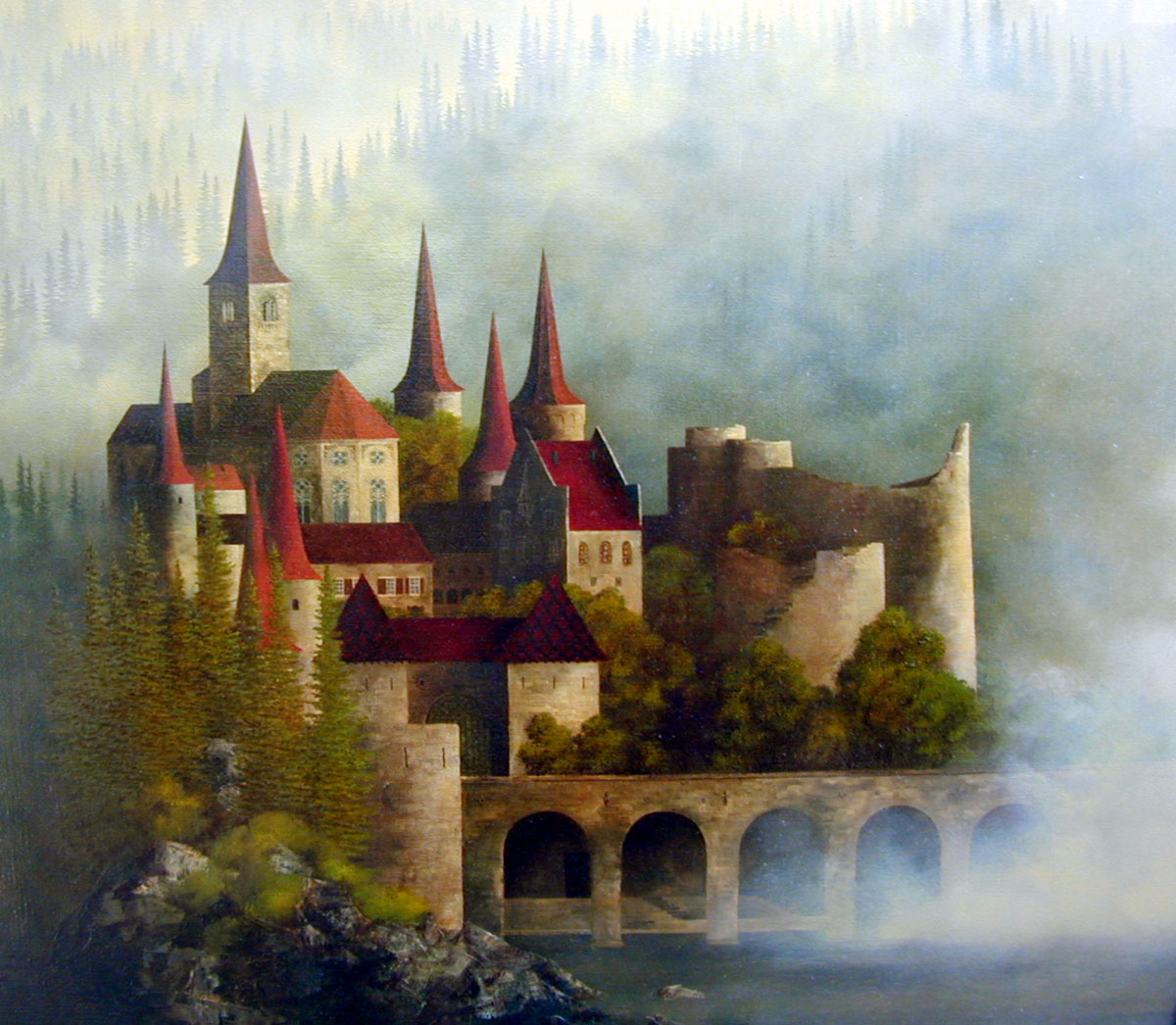 |
| Final glazes round or give volume not only to the shapes of the elements in the composition, but to the colors in which those elements are draped. And because the glazes are thin, the colors that ultimately result from the accumulation of the glazes arise from the literal depth of those under-layers, which are actually interleaved by the light falling upon the painting. That is one of the primary reasons colors achieved by glazing tend to be irridescent. |
Tags: The Grey Havens, 2018, Project commentaries
Browse articles by year: 2025 . 2024 . 2023 . 2022 . 2021 . 2020 . 2019 . 2018 . 2017 . 2016 . 2015 . 2014 . 2013 . 2012 . 2011 . 2010 . 2009 . 2008 . 2007 . 2006 . 2005 . 2004 . 2003 . 2002 . 2001 . 2000 . 1999 . 1998 . 1997 . 1996
Browse articles by topic: Art lessons . BenHaven Archives . Blank art diaries . Fine art photography . Framing . Illustration . Inspiration and creativity . Isles of Rune . Limited Editions Collection . My Fathers Captivity . News . Novellas . Oil paintings and prints . Operations announcements . Orders and shipping . Overview . Portfolios . The Papers of Seymore Wainscott . Project commentaries . Recipes by Nancy Young . Recommended reading . Recommended viewing . Temple artworks . The Storybook Home Journal . Tips and techniques . Tools supplies and operations
Browse articles by topic: Art lessons . BenHaven Archives . Blank art diaries . Fine art photography . Framing . Illustration . Inspiration and creativity . Isles of Rune . Limited Editions Collection . My Fathers Captivity . News . Novellas . Oil paintings and prints . Operations announcements . Orders and shipping . Overview . Portfolios . The Papers of Seymore Wainscott . Project commentaries . Recipes by Nancy Young . Recommended reading . Recommended viewing . Temple artworks . The Storybook Home Journal . Tips and techniques . Tools supplies and operations